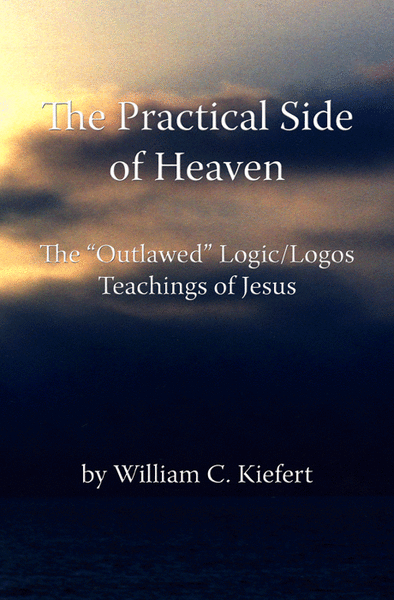
Learn more about The Practical Side of Heaven
Copyright William C. Kiefert. All Rights Reserved.
Chapter Two, Part Seven: What is the Assumption Upon Which Logic Rests?
Many consider Plato’s Theory of Noncontradiction, “the axiom [or basic assumption beneath] … all logic” ; namely “the same thing clearly cannot act or be acted upon in the same part or in the same relation to the same thing at the same time, in contrary ways: and therefore whenever this contradiction occurs in things apparently the same, we know that they are really not the same but different.”
Plato’s theory seems self-evident, but shortly we will see that it is not. The important thing here is to recognize the Aristotle used Plato’s Theory of Noncontradiction (some call it his Theory of Forms) to justify his system of logic. To this day we use Aristotle’s system of logic as the standard for correctly relating ideas or reasoning.
Note: I use the term ‘class’ in its philosophical sense of categories or classes of like objects or ideas – not social classes.
Plato’s theory of noncontradiction is one of the first written examples of the basic axiom upon which all logic rests. The similarity of Gautama’s system of logic demonstrates it, too, rests on a standard similar to Plato’s. Let us now examine Plato’s Theory of Forms/nature.
Take the seemingly trivial philosophical question: “What justifies our using the same word to refer to different objects?” For example, we use the word “dog” to refer to many animals, which we classify together, and the word “bird” to refer to animals in another class. How can one word refer to different things?
The answer that Plato (428-347 B.C.) offered was that things referred to by a single term all had something in common. Precisely what they had in common is not easy to say. In fact, no definitive explanation of what any class has in common has ever been agreed upon. Nevertheless, we unwittingly accept that every class of objects and ideas do have something in common. Many, for example, believe that human nature is corrupt. How could so many believe this if they did not assume a human nature that can be corrupted? Also, how could anyone make a statement about human nature, without first defining it, if they did not take it for granted that everyone had some common idea of what that nature was.
Let us assume, however, that this commonality in, say, dogs and birds, can be expressed as “dogness” or “birdness.” It is, in part, the shape or the form which the things have: dogs have a different shape or form than birds. In effect, a form is like a mold or pattern which gives each thing in the world its shape and nature. It is, also, our idea of what they essentially are: when we think of dogs, we have a different idea in mind than when we think of birds.
Plato made this idea the basis of his theory of forms or nature by “assuming” that every class or category of objects and ideas is represented by one specific form, essence, or nature. And that one form represents the nature of the whole class. The form or nature of Dogness, for example, is what makes something a dog; the nature of Birdness is what makes something a bird; and so on. All dogs share in Dogness, as all birds share in Birdness.
The nature of each class is the standard by which each class is measured. Plato thought of these natures or essences as ideal, eternal, and unchanging. Therefore, he argued, they must exist in a realm beyond the physical world, because everything in the physical world changes. And these forms must exist in a way which can be apprehended by the mind.
Aristotle basically agreed with Plato that there was a single nature for each class. He denied, however, that these natures existed in a supernatural realm. Rather, he held that each individual thing had inherently the nature or form which made it the particular individual that it was. A dog was a dog, for example, not because it shared some transcendent nature with all other dogs, but because it had within it the nature of a dog. But regardless of where these natures or forms were thought to exist, the consequence of this theory is to assume that all members of a particular class share the same nature. As we shall now see, this assumption underlies the very structure of our logic, and it becomes the basis of our thinking and reasoning process.
When Aristotle and Gautama formulated their systems of logic, the assumption that all classes are reducible to a single nature lay at the basis of their thinking. Implicitly, that assumption, silently but surely, provided the justification for the three basic laws of thought.
For example, the credibility of the three present basic laws of thought — the laws of identity, noncontradiction, and excluded middle, are justified only if every class has one nature, as the prevailing principle assumes. If a class, say ‘X,’ has more than one nature, we could not be sure that ‘X’ is ‘X,’ as the law of identity claims, or that ‘X’ is ‘X’ and not non-X, or anything in between, as stated by the laws of noncontradiction and excluded middle.
Let me begin by explaining how the prevailing theory of nature, through our basic laws of logic, subject us to judgmental reasoning. After which, I will argue that the prevailing theory does not fit all classes, offer a theory that does, and propose additional laws of logic that justify nonjudgmental reasoning.
By judgmental reasoning, I mean relating ideas in terms of absolutes, either/or, and superior/inferior.
By nonjudgmental reasoning, I mean relating ideas in terms of inclusiveness, both/and, and equality. Note: I may interchange spiritual, social, paradoxical, and quantum reasoning with the term nonjudgmental reasoning. In principle, all of these types of reasoning are nonjudgmental.
